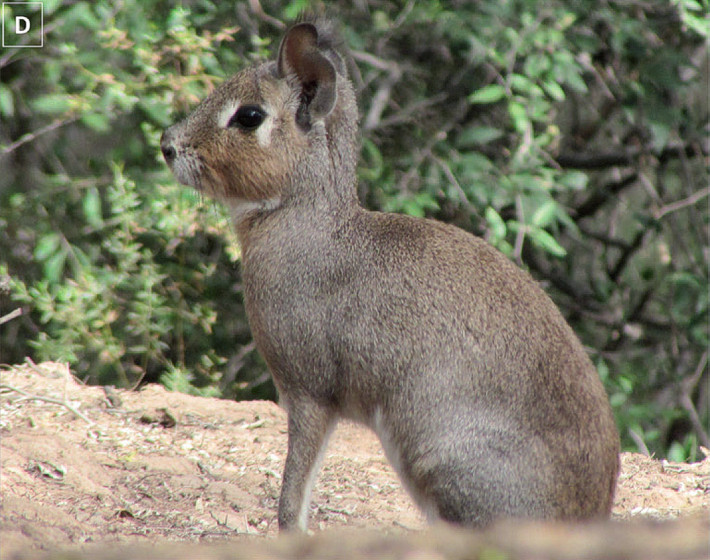New records of the Chacoan cavy, Dolichotis salinicola (Burmeister, 1876), in the province of San Luis, Argentina, contributions to its natural history
DOI:
https://doi.org/10.31687/SaremNMS24.08.1Keywords:
Chacoan cavy, distribution, Dry Chaco, new localities, San LuisAbstract
The Chacoan cavy has a wide distribution in Argentina, being distributed in arid and semi-arid lands of the Chaco region. However, the southern limit of this distribution is unclear, finding discrepancies between authors. This work provides new records of Dolichotis salinicola (Burmeister, 1876) in San Luis province. These records were made by direct observations and the revision of material deposited in biological collections. The present note is a contribution to determining the southern limit of the distribution of the species, and to the knowledge of the species' natural history.
References
Barquez, R. M., M. M. Díaz, & R. A. Ojeda. 2006. Mamíferos de Argentina. Sistemática y distribución. SAREM, Mendoza.
Burkart, R., N. O. Barbaro, R. O. Sánchez, & D. A. Gómez. 1999. Eco-regiones de la Argentina. Administración de Parques Nacionales. <https://sib.gob.ar/archivos/Eco_regiones_de_la_Argentina_1999.pdf>.
Campo, D. H., D. A. Caraballo, G. H. Cassini, S. O. Lucero, & P. Teta. 2020. Integrative taxonomy of extant maras supports the recognition of the genera Pediolagus and Dolichotis within the Dolichotinae (Rodentia, Caviidae). Journal of Mammalogy 101:817–834. https://doi.org/10.1093/jmammal/gyaa038.
Carrizo, M. C., et al. 2020. Marsupiales y roedores de la provincia de San Luis. 1ª ed. Nueva Editorial Universitaria, Universidad Nacional de San Luis, San Luis. <http://www.neu.unsl.edu.ar/wp-content/uploads/2020/05/Marsupiales-y-Roedores-de-la-provincia-de-San-Luis.pdf>.
Chillo, V., D. Rodríguez, & R. A. Ojeda. 2010. Niche partitioning and coexistence between two mammalian herbivores in the Dry Chaco of Argentina. Acta Oecologica 36:611–616. https://doi.org/10.1016/j.actao.2010.09.006.
Grigera, D. E., & E. H. Rapoport. 1983. Status and distribution of the European hare in South America. Journal of Mammalogy 64:163–166. https://doi.org/10.2307/1380771.
Lomolino, M. V. 2001. Elevation gradients of species-density: historical and prospective views. Global Ecology & Biogeography 10:3–13. https://doi.org/10.1046/j.1466-822x.2001.00229.x.
Mora, M. S., & A. A. Ojeda. 2019. Dolichotis salinicola. Categorización 2019 de los Mamíferos de Argentina según su riesgo de extinción. Lista Roja de los mamíferos de Argentina (SAyDS–SAREM, eds.). <http://cma.sarem.org.ar>.
Monteverde, M., S. Cirignoli, N. Bonino, A. Gonzalez, & G. Aprile. 2019. Lepus europaeus. Categorización 2019 de los Mamíferos de Argentina según su riesgo de extinción. Lista Roja de los mamíferos de Argentina (SAyDS–SAREM, eds.). <http://cma.sarem.org.ar>.
Patton, J. L., U. F. Pardiñas, & G. D'Elía (eds.). 2015. Mammals of South America, Vol. 2: rodents. University of Chicago press, Chicago.
Rundel, P., et al. 2007. Arid and semi-arid ecosystems. The physical geography of South America (T. T. Veblen, K. R. Young, & A. R. Orme, eds.). Oxford University Press, Oxford.
Spector, S. 2002. Intersecciones biogeográficas como áreas prioritarias para la conservación de la biodiversidad. Conservation Biology 16:1480–1487.
Teta, P. 2021. Biodiversidad, colecciones biológicas y colecta de especímenes ¿por qué tenemos que seguir colectando? Mastozoología Neotropical 28:21.28.1.0.37. https://doi.org/10.31687/saremMN.21.28.1.0.37.
Torres, R. & D. Tamburini. 2018. Mamíferos de Córdoba y su estado de conservación. 1ª edición. Editorial de la Universidad Nacional de Córdoba, Córdoba.
Torres, R., & J. P. Jayat. 2010. Modelos predictivos de distribución para cuatro especies de mamíferos (Cingulata, Artiodactyla y Rodentia) típicas del Chaco en Argentina. Mastozoología Neotropical 17:335–352.
Weiler Gustafson, A., et al. 2018. Guía para la identificación de mamíferos medianos y grandes del Chaco Seco. Editorial de la Universidad Nacional de Asunción, San Lorenzo.
Zak, M. R., M. Cabido, & J. G. Hodgson. 2004. Do subtropical seasonal forests in the Gran Chaco, Argentina, have a future? Biological Conservation 120:589–598. https://doi.org/10.1016/j.biocon.2004.03.034.

Downloads
Published
How to Cite
Issue
Section
License
Copyright (c) 2024 Victor M. Pardo, Lucia Martinez Retta, Samuel E. Olivieri Bornand, Ailin Gatica, Ana C. Ochoa

This work is licensed under a Creative Commons Attribution-NonCommercial 4.0 International License.

